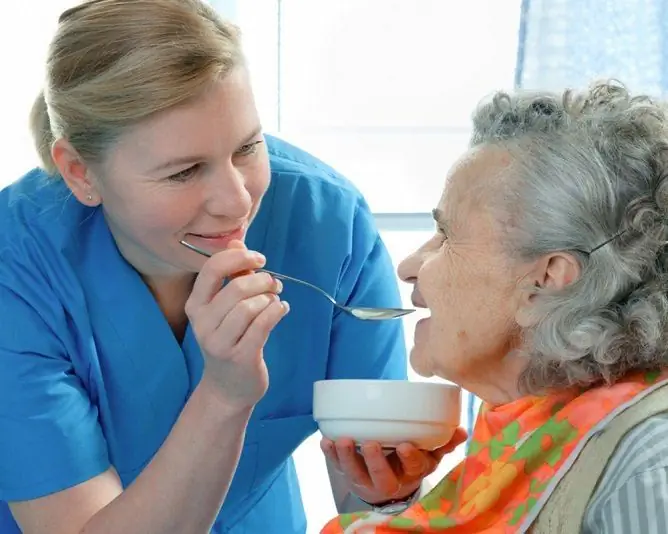- Author Rachel Wainwright [email protected].
- Public 2023-12-15 07:39.
- Last modified 2025-11-02 20:14.
Diet after a heart attack: nutrition and its regime, an approximate menu for a week
The content of the article:
- Purpose of the diet after heart attack
- Basic principles of a post-heart attack diet for men and women
-
Diet at different periods of a heart attack
- Diet for the acute period
- Diet for the subacute period
- Diet for the stage of scarring
- Allowed Products
- Prohibited foods
- Diet after myocardial infarction for men and women
- Menu
- Video
Diet after myocardial infarction - an acute violation of cardiac circulation, as a result of which a portion of the myocardium remains without nutrition, which dies (necrotizes), is an important part of rehabilitation. Various pathologies that affect the state of blood vessels can lead to myocardial infarction: hypertension, atherosclerosis, diabetes mellitus, stress, physical inactivity, obesity, and bad habits. Not in the last place among the factors contributing to the development of pathology are gross errors in nutrition.

Diet in the postinfarction period is an important component of rehabilitation
Rehabilitation measures include supportive drug therapy, regular monitoring by a cardiologist, physiotherapy exercises, monitoring blood pressure, glucose and cholesterol levels, avoiding bad habits, preventing stressful situations, normalizing body weight, and rational dietary nutrition. Proper nutrition after a heart attack can significantly improve the functional capacity of the heart and reduce the risk of recurrent attacks.
Purpose of the diet after heart attack
The diet after a heart attack is designed to accelerate the recovery processes in the myocardium, create favorable conditions for the normalization of coronary circulation, normalize metabolism, and ensure full bowel function. Nutritional therapy reduces the burden on the kidneys, relieves edema, helps to strengthen the heart muscle, helps in the fight against heart rhythm disturbances and helps maintain all body functions.
After suffering an extensive heart attack, table 10 according to Pevzner is shown. This diet is used for cardiovascular diseases and diseases of the nervous system, it includes foods that improve blood circulation and strengthen the heart and blood vessels. Table 10 provides balanced nutrition and at the same time gentleness to the body.
Basic principles of a post-heart attack diet for men and women
Both men and women who have had myocardial infarction should become accustomed to following these rules:
- Eat regularly, evenly distributing the daily menu into small portions. Neither severe hunger nor overeating is equally unacceptable.
- Limit salt intake. Salt increases blood pressure, fluid retention and edema;
- Limit the intake of fats and easily digestible carbohydrates.
- Exclude from the diet foods that irritate the gastric mucosa, increase nervous excitability, and cause fluid retention in the body.
- Observe the drinking regime. In the acute and subacute period, the total daily volume of fluid is limited to 1-1.2 liters.
- To enrich the diet with microelements (primarily magnesium, potassium, iodine), vitamins, unsaturated fatty acids, dietary fiber, and alkalizing products.
- Carry out culinary processing of products in gentle ways in order to preserve the maximum amount of nutrients in them.
- Eat food at a moderate temperature - from room to warm, too cold and hot dishes are not recommended.
- Limit the daily calorie intake. Since in the post-infarction period, patients are limited in physical activity, it is necessary to ensure that the energy value of food corresponds to energy expenditure. Overweight patients are recommended to reduce the daily caloric intake by 200-300 kcal from the recommended one for their age and nature of activity.
Similar dietary requirements are imposed after undergoing stenting, in addition, in this case, it is especially necessary to carefully monitor the drinking regime, since it is critically important to avoid dehydration leading to blood thickening.
Diet at different periods of a heart attack
For each of the main periods of heart attack (acute, subacute and scarring), a special diet is recommended.
Diet for the acute period
What can you eat after a heart attack? In the first week after a heart attack, in the acute period, the basis of nutrition is made up of liquid and semi-liquid, crushed and mashed dishes. Allowed: steamed meatballs or cutlets of veal, chicken or fish fillets, viscous cereals, milk and dairy products, steam omelet, puree soups, stewed vegetables, fruit and berry compotes, jelly, fruit drinks, rosehip broth. The daily calorie content is 1100-1300 kcal.

In the acute period of a heart attack, mashed soups are recommended for patients
Diet for the subacute period
In the second phase, which lasts two to three weeks, the diet becomes less restrictive. Dishes do not need to be chopped. The diet should contain fresh and cooked vegetables, easily digestible meat, eggs, dairy products, cereals, bran bread, vegetable and butter, dried fruits. The daily calorie content is 1600-1800 kcal.
Diet for the stage of scarring
The scarring phase begins around the fourth week after a heart attack and lasts 2 to 6 months. At this time, the cardiovascular system adapts to new conditions of functioning. An easily digestible balanced diet enriched with potassium is recommended. Potassium helps to remove excess water from the body, helps to eliminate edema, is necessary for the normal functioning of blood vessels, capillaries, heart muscle. They are rich in dried fruits (dried apricots, raisins, prunes, etc.), fresh vegetables and fruits, dairy products and fish. It is allowed to consume up to 5 g of salt per day. Daily calorie intake is usually recommended for a given gender, age and occupation.
Allowed Products
The list of products recommended for consumption is large enough to provide the patient with a varied and balanced diet for every day:
- lean meat - veal, chicken, turkey, rabbit;
- fish (especially fish of the northern seas, rich in polyunsaturated fatty acids);
- dairy products - milk, yogurt, fermented baked milk, kefir, cottage cheese, cheese;
- eggs;
- cereals - oatmeal, buckwheat, millet, rice (especially unpolished);
- bakery products - dried white bread, whole grain bread, uncooked biscuits ("Zoological" and the like);
- vegetables - any, primarily pumpkin, zucchini, eggplant, tomatoes, carrots, cucumbers, potatoes, all types of cabbage, onions, garlic, parsley, horseradish, dill, fennel;
- oils - butter, vegetable (olive, sunflower, pumpkin, sesame).
Of the spices, dry herbs that do not have a pungent taste are permissible for use, for example, it is useful to add dried dill, parsley, basil, thyme, etc. to dishes.
What fruits are allowed after a heart attack? Almost any. Citrus fruits, apricots, bananas, grapes, dried fruits (primarily raisins, figs and dried apricots) are especially recommended. Berries are welcome in the diet - currants, raspberries, viburnum, blueberries, cranberries.

Dried fruits are of great benefit during the recovery period after a heart attack.
Since myocardial infarction often occurs in overweight people, the use of high-calorie foods, especially fatty foods and confectionery, should be limited or completely eliminated from the diet. Acceptable sweet foods (in moderation): Dried fruit, jam or preserves, candy, marmalade, marshmallows, fruit jellies, and milk puddings. Sugar should be consumed in limited quantities, or even better, replaced with honey.
It is necessary to observe the drinking regime. For each period and for each patient, it may be different (for some patients, fluid intake is limited to combat edema), but during the rehabilitation period it is usually recommended to drink at least four glasses of water a day. Other drinks: fruit and berry compotes, unsweetened fruit drinks, jelly, freshly squeezed fruit, berry and vegetable juices, herbal teas, weak tea. Sometimes it is permissible to drink a cup of cocoa or coffee with milk.
All dishes should be prepared using dietary methods: boiling, stewing, baking, steaming. In the late rehabilitation period, grilling is allowed. Fried foods should be discarded. As for the recipes for the dishes, no special recipes are required, anything that can be easily prepared at home from permitted products will do.
Prohibited foods
After a heart attack, you cannot eat fatty meats, sausages, offal, smoked meats, canned food, pickles, legumes, mushrooms, pastries, chocolate, hot spices, strong tea, coffee, sweet carbonated drinks.
Can I drink alcohol? There is an opinion that red wine and some other alcoholic beverages can be drunk in moderation, and strong ones are allowed if drinking is not allowed, but this opinion is erroneous. Patients who have had a heart attack should completely abandon not only vodka, beer, cognac and other spirits, but also low-alcohol drinks - wine, beer, cider, etc. Simply put, all alcohol is prohibited.

Low alcohol drinks after a heart attack are just as prohibited as strong alcohol
Diet after myocardial infarction for men and women
The diet after a heart attack is just as important as the diet.
Fractional meals are optimal - frequent meals at approximately regular intervals. There should be at least 5 meals per day: 3 main (breakfast, lunch, dinner) and two additional. The portions are small, approximately the size of the patient's fist. The last meal is no later than three hours before bedtime.
This mode allows you to relieve the digestive system and at the same time ensure its optimal functioning. In addition, fractional nutrition allows you to optimize metabolism and normalize body weight. For patients who have had myocardial infarction, it is advisable to observe a fractional diet for life.
Menu
An approximate menu for a week during the rehabilitation period after a heart attack is presented in the table.
| Day of week | Approximate diet |
| Monday |
First breakfast: oatmeal, yogurt or boiled soft-boiled egg. Second breakfast: fruit salad. Lunch: vegetable soup, steamed chicken cutlet with vegetable puree, dried fruit compote. Afternoon snack: rosehip broth, banana. Dinner: boiled fish, steamed vegetables, herbal tea. Late dinner: kefir. |
| Tuesday |
First breakfast: an omelet of two eggs, toast, tea. Second breakfast: fruit puree. Lunch: vegetable soup with fresh herbs, boiled beef with cauliflower garnish, dried fruit compote. Afternoon snack: jelly. Dinner: cottage cheese casserole with fruit pieces. Late dinner: fruit salad with yoghurt. |
| Wednesday |
First breakfast: oatmeal in milk, tea. Second breakfast: stewed vegetables. Lunch: vegetable soup with rice, steamed chicken cutlet with vegetable garnish, fruit juice. Afternoon snack: rosehip broth, dry biscuits. Dinner: boiled fish, fresh cucumbers, compote. Late dinner: a cup of cottage cheese with sour cream and raisins. |
| Thursday |
First breakfast: soft-boiled egg, toast with cheese, tea with lemon. Second breakfast: baked apples. Lunch: vegetable soup, beef with cauliflower and green beans, fruit compote. Afternoon snack: cookies, tea, pear or apple. Dinner: curd casserole, herbal tea. Late dinner: fermented baked milk. |
| Friday |
First breakfast: omelet with tomatoes, compote. Second breakfast: casserole with fruit. Lunch: vegetable soup, steamed chicken cutlet, stewed cabbage garnish, compote. Afternoon snack: any fruit. Dinner: fish meatballs and mashed potatoes. Late dinner: yoghurt. |
| Saturday |
First breakfast: buckwheat porridge with milk, tea. Second breakfast: fresh vegetable salad, toast. Lunch: chicken broth, boiled chicken with stewed vegetables, dried fruit compote. Afternoon snack: berry jelly. Dinner: stuffed zucchini, herbal tea. Late Dinner: Milk Pudding. |
| Sunday |
First breakfast: toast with cheese, tea. Second breakfast: rice pudding. Lunch: green borscht, grilled chicken fillet, grilled vegetables, berry juice. Afternoon snack: milk or kefir, dry biscuits. Dinner: spaghetti with stewed vegetables. Late dinner: yoghurt. |
Video
We offer for viewing a video on the topic of the article:

Anna Kozlova Medical journalist About the author
Education: Rostov State Medical University, specialty "General Medicine".
Found a mistake in the text? Select it and press Ctrl + Enter.






